Elementree — extending our branches across Buckinghamshire and beyond
-
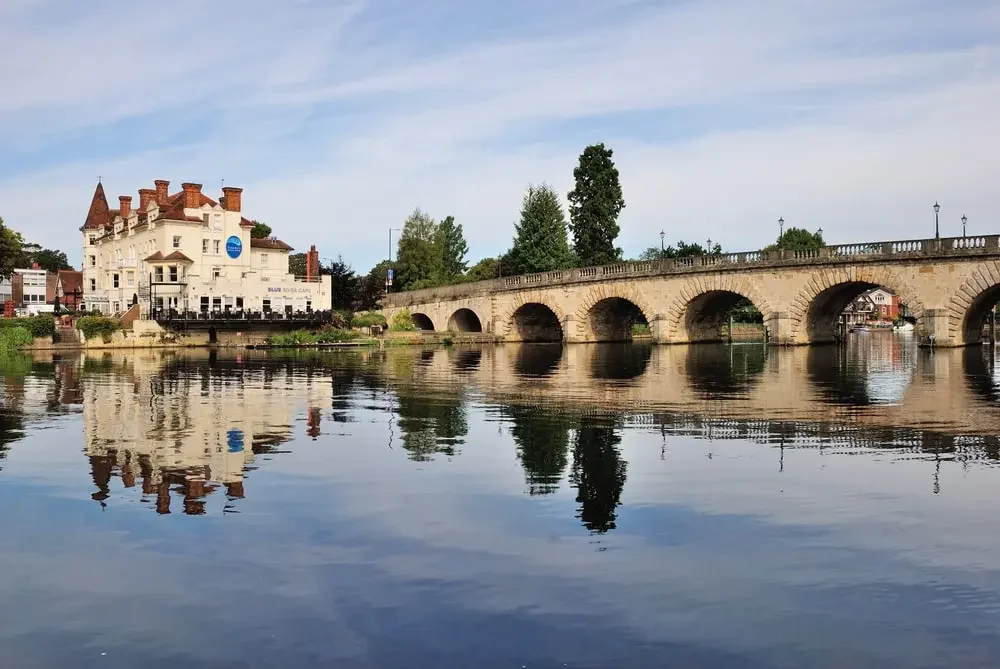
MAIDENHEAD
Maidenhead is a prosperous riverside town in Berkshire, known for its green spaces, good transport links, and family-friendly atmosphere. It sits on the River Thames, offering scenic walks, rowing, and boating, particularly around Boulter’s Lock and Ray Mill Island.
The town blends historic charm with modern development — traditional Victorian and Edwardian homes stand alongside new riverside apartments and retail areas. It’s part of the Royal Borough of Windsor and Maidenhead, and benefits from Crossrail (the Elizabeth Line), giving fast connections to London.
Maidenhead’s surroundings are leafy and semi-rural, with nearby villages like Cookham and Bray adding a countryside feel. The area is popular with commuters and families thanks to excellent schools, parks, and access to the Chiltern Hills and the M4 corridor. Overall, it’s a well-kept, suburban town with a strong community and plenty of greenery.
Maidenhead features a diverse mix of native and ornamental trees, reflecting its riverside setting and established residential areas. Common species include oak, ash, beech, sycamore, and lime, along with willow and poplar near the River Thames. Many parks and gardens contain horse chestnut, plane, cherry, and cedar trees, adding to the town’s leafy suburban character. The surrounding countryside also supports areas of mixed deciduous woodland, typical of the Thames Valley landscape.
-

BEACONSFIELD
Beaconsfield is an affluent, picturesque market town in south Buckinghamshire, known for its leafy streets, elegant homes, and village atmosphere. It’s divided into Old Beaconsfield, with its historic high street of Georgian buildings and traditional pubs, and New Beaconsfield, which developed around the railway and features larger detached houses and modern amenities.
The town is surrounded by woodland and open countryside, giving it a green, semi-rural character while still offering excellent transport links — the Chiltern Line provides a quick route to London Marylebone, and the M40 is close by.
Beaconsfield is popular with commuters and families, thanks to its high-performing schools, boutique shops, cafés, and strong community feel. Its tree-lined avenues, mature gardens, and proximity to the Chiltern Hills Area of Outstanding Natural Beauty make it one of the most desirable places to live in the region.
Beaconsfield is characterised by its mature tree cover and wooded surroundings, typical of the Chiltern Hills. Common species include beech, oak, sycamore, and lime, with horse chestnut, birch, and Scots pine also widespread in gardens and along avenues. The town’s older areas and nearby countryside feature ancient beech and oak woodland, giving Beaconsfield its distinctive leafy, semi-rural character. Many properties are framed by large ornamental and native trees, contributing to the area’s green and well-established landscape.
-

MARLOW
Marlow is a charming riverside town in Buckinghamshire, known for its scenic beauty, lively community, and relaxed yet sophisticated feel. Set on the River Thames, it features the iconic Marlow Bridge, Georgian architecture, and tree-lined streets filled with independent shops, cafés, and restaurants — including several renowned dining spots.
The town is surrounded by rolling Chiltern countryside and ancient woodland, giving it a green, picturesque backdrop.
Marlow features a rich variety of trees typical of the Chilterns and the Thames Valley. Common native species include oak, beech, ash, sycamore, and birch, alongside willow and alder near the River Thames. The town’s parks, gardens, and older properties also feature horse chestnut, lime, cedar, and cherry trees, contributing to its leafy, picturesque character. Many of the mature beech and oak trees in and around Marlow are characteristic of the surrounding Chiltern woodland landscape.
-
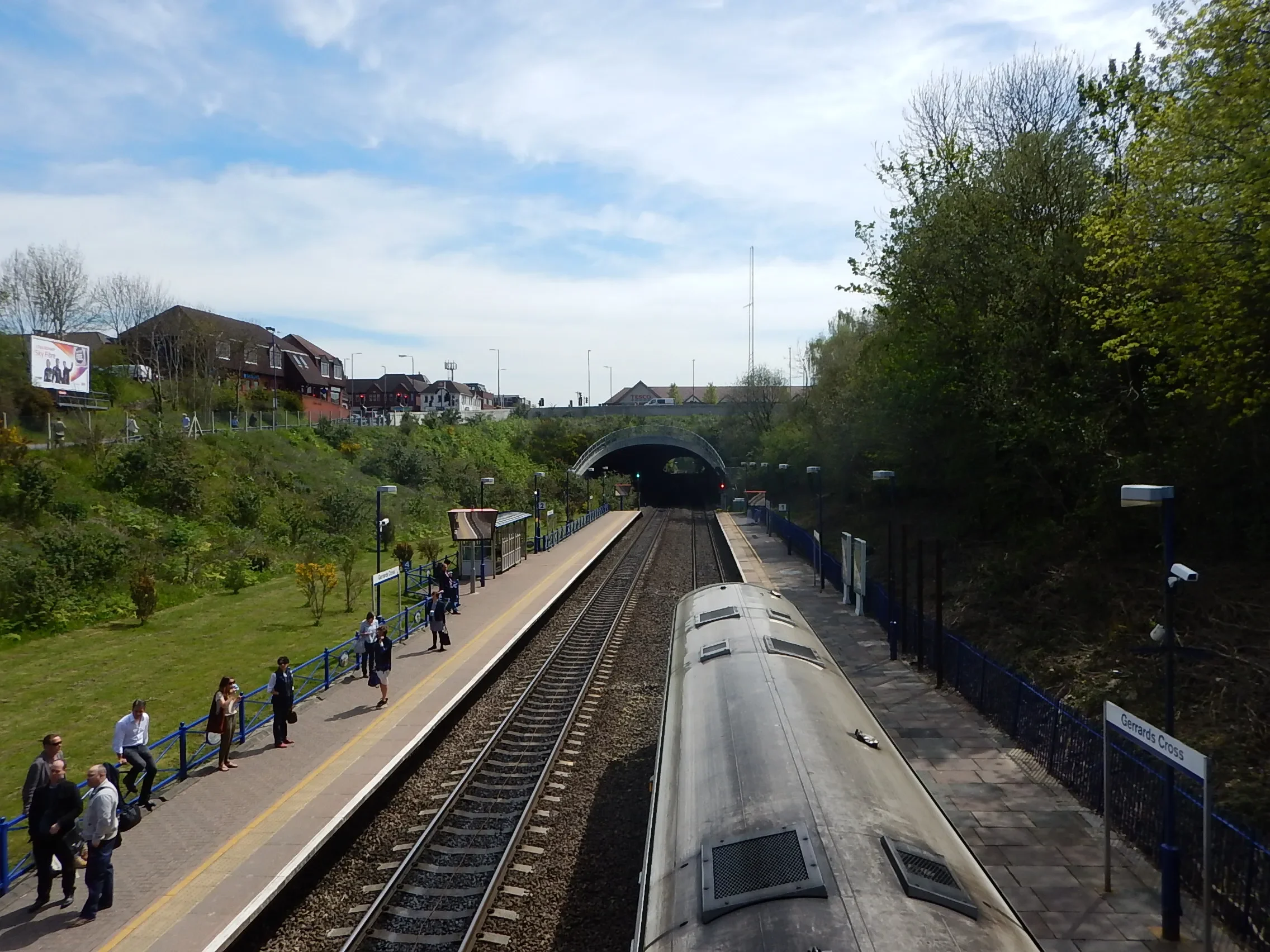
GERRARDS CROSS
Gerrards Cross is an affluent and leafy town in south Buckinghamshire, often described as one of the most desirable places to live in the London commuter belt. It combines spacious, tree-lined residential areas with a village-like centre that offers boutique shops, cafés, and restaurants.
The town is surrounded by woodland and open countryside, giving it a green and peaceful character.
Gerrards Cross is known for its leafy, mature character, with many broadleaf trees typical of southern England. Common species include oak, beech, sycamore, lime, and horse chestnut, which line the residential roads and gardens. The area also features Scots pine, cedar, and yew, reflecting its long-established gardens and wooded surroundings. Many parts of Gerrards Cross retain a woodland feel, with remnants of ancient beech and oak woodland that are characteristic of the Chilterns landscape.
-
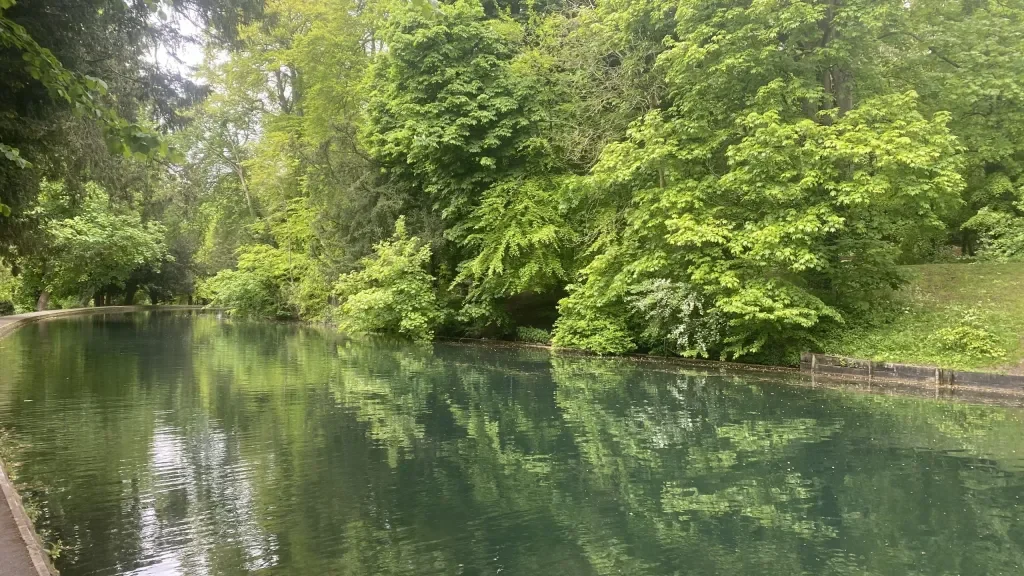
HIGH WYCOMBE
High Wycombe is a large market town in Buckinghamshire with a mix of historic character and modern development. Set in a valley surrounded by the Chiltern Hills, it offers green countryside views alongside a busy town centre.
The town has a strong industrial heritage, once famous for its furniture-making,
High Wycombe and its surroundings are rich in woodland and mature tree cover, reflecting their location in the Chiltern Hills Area of Outstanding Natural Beauty. The area is especially known for its beech woodlands, historically used in the local furniture-making industry.
Common tree species include beech, oak, ash, sycamore, and hornbeam, with silver birch and field maple also widespread. In parks and residential areas, you’ll also find lime, horse chestnut, and ornamental cherry trees, adding seasonal colour and variety.
The hills and valleys around Wycombe are densely wooded, giving the town its green, sheltered character and making the surrounding landscape one of the most distinctive tree-covered areas in southern England.
-
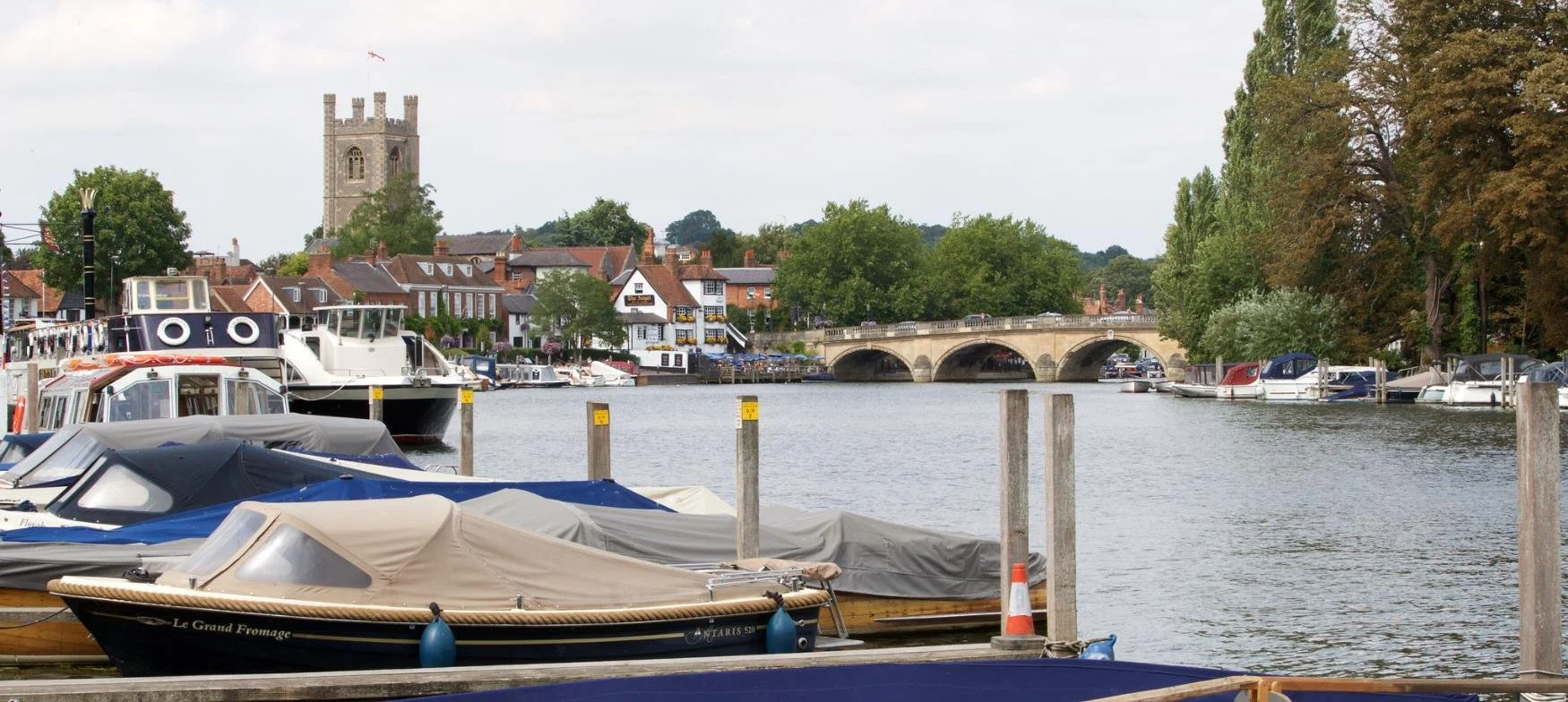
HENLEY-ON-THAMES
Nestled along the iconic River Thames and surrounded by lush, rolling countryside, Henley-on-Thames is a quintessential English town that offers a perfect blend of charm, history, and modern appeal.
Henley-on-Thames is surrounded by lush, mature woodland and riverside greenery, typical of the Thames Valley and Chiltern Hills landscape. Common trees include beech, oak, ash, and sycamore, with willow and poplar lining the riverbanks.
The town’s parks and gardens feature lime, horse chestnut, cherry, and cedar trees, adding colour and character throughout the seasons. The surrounding countryside contains stretches of ancient beech woodland, making Henley one of the most picturesque and tree-rich towns along the Thames.
-
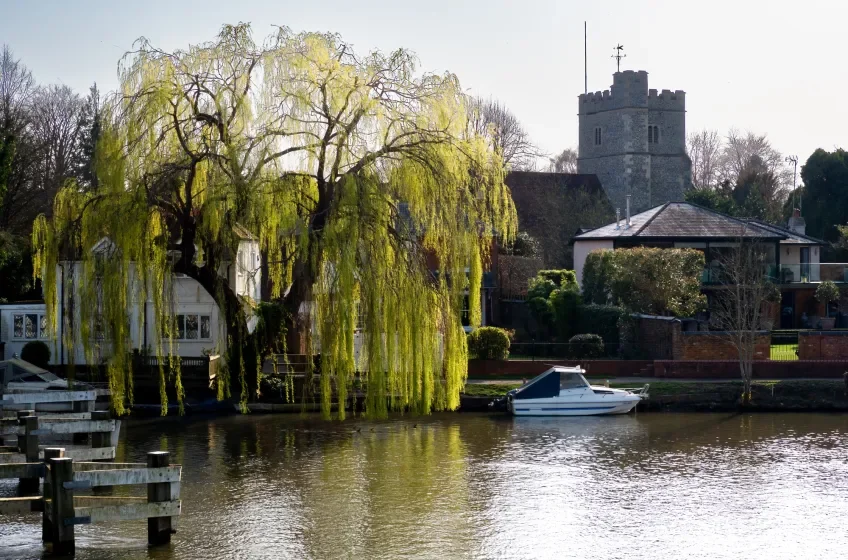
COOKHAM
Cookham is a beautiful and historic village on the River Thames in Berkshire, known for its riverside charm, artistic heritage, and strong community spirit. It’s made up of three main areas — Cookham Village, Cookham Dean, and Cookham Rise — each with its own character, from quaint cottages and pubs by the river to leafy lanes and countryside views higher up the hill.
A picturesque Thames-side village surrounded by mature trees and wooded landscapes typical of the Thames Valley. Along the river, you’ll find willow, alder, and poplar, while the higher ground and surrounding countryside feature oak, beech, ash, and sycamore.
In gardens and village lanes, horse chestnut, lime, and ornamental cherry trees add to Cookham’s leafy, rural charm. The area’s mix of riverside vegetation and ancient woodland gives it a green, timeless character, often celebrated in the paintings of Stanley Spencer, who captured its natural beauty.
-
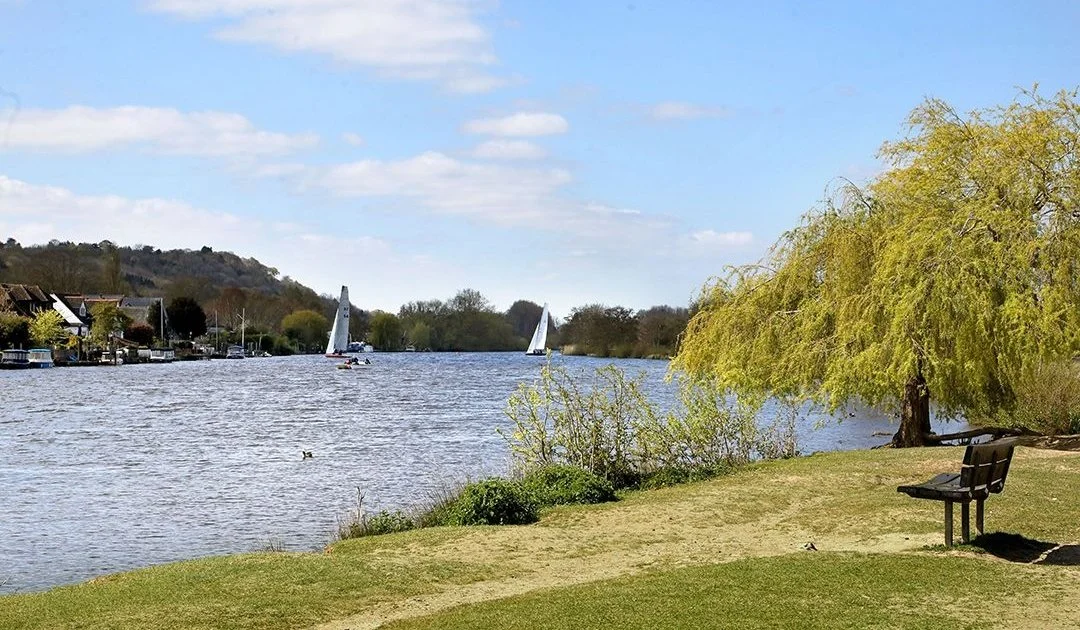
BOURNE END
Bourne End is a welcoming riverside village in Buckinghamshire, known for its relaxed atmosphere, community feel, and scenic setting on the River Thames between Marlow and Cookham.
It offers a blend of modern convenience and village charm, with local shops, cafés, and pubs, plus excellent transport links — a train to Maidenhead connects residents to London via the Elizabeth Line. The area is popular with families and professionals, thanks to its good schools, friendly community, and riverside lifestyle.
Surrounded by woodland, meadows, and riverbank walks, Bourne End feels leafy and semi-rural, yet it’s only minutes from larger towns. Many homes are tucked among mature trees and green spaces, giving the village a peaceful, well-established character that reflects the beauty of the Thames Valley.
Bourne End has a rich variety of trees, reflecting its riverside and Chiltern-edge landscape. Along the River Thames, you’ll find willow, alder, and poplar, which thrive in the moist ground. Moving away from the river, the village and surrounding countryside feature oak, beech, ash, and sycamore, typical of the Chiltern woodlands nearby.
In gardens and along village roads, there are many lime, horse chestnut, birch, and ornamental cherry trees, adding seasonal colour and character. The mix of riverbank vegetation, mature woodland, and well-treed residential areas gives Bourne End its leafy, green, and peaceful feel, blending natural and suburban beauty perfectly.
-

AMERSHAM
Amersham is a charming and historic market town in the Chiltern Hills, known for its beautiful scenery, period architecture, and excellent transport links. It’s divided into Old Amersham, with its medieval high street, traditional pubs, and historic buildings, and Amersham-on-the-Hill, a more modern area that grew around the Metropolitan line station, making it a popular spot for London commuters.
The town is surrounded by rolling countryside and ancient beech woodland, giving it a green, semi-rural atmosphere despite its proximity to London. It’s well known for its excellent schools, independent shops, and strong sense of community, making it especially attractive to families and professionals.
Overall, Amersham combines heritage charm with modern convenience, offering a leafy, elegant, and well-connected lifestyle in the heart of the Chilterns.
Surrounded by some of the finest woodland in the Chiltern Hills, giving it a distinctly green and wooded character. The area is especially known for its ancient beech forests, once used for the region’s famous furniture-making trade.
Common species include beech, oak, ash, and hornbeam, along with sycamore, birch, and field maple. In residential areas and parks, you’ll also find lime, horse chestnut, cherry, and cedar trees, which add structure and seasonal colour.
The mix of mature woodland, hedgerows, and tree-lined roads makes Amersham feel leafy and tranquil, while the surrounding Chiltern beechwoods — some designated as Sites of Special Scientific Interest (SSSIs) — are among the most beautiful and ecologically valuable forests in southern England.
-
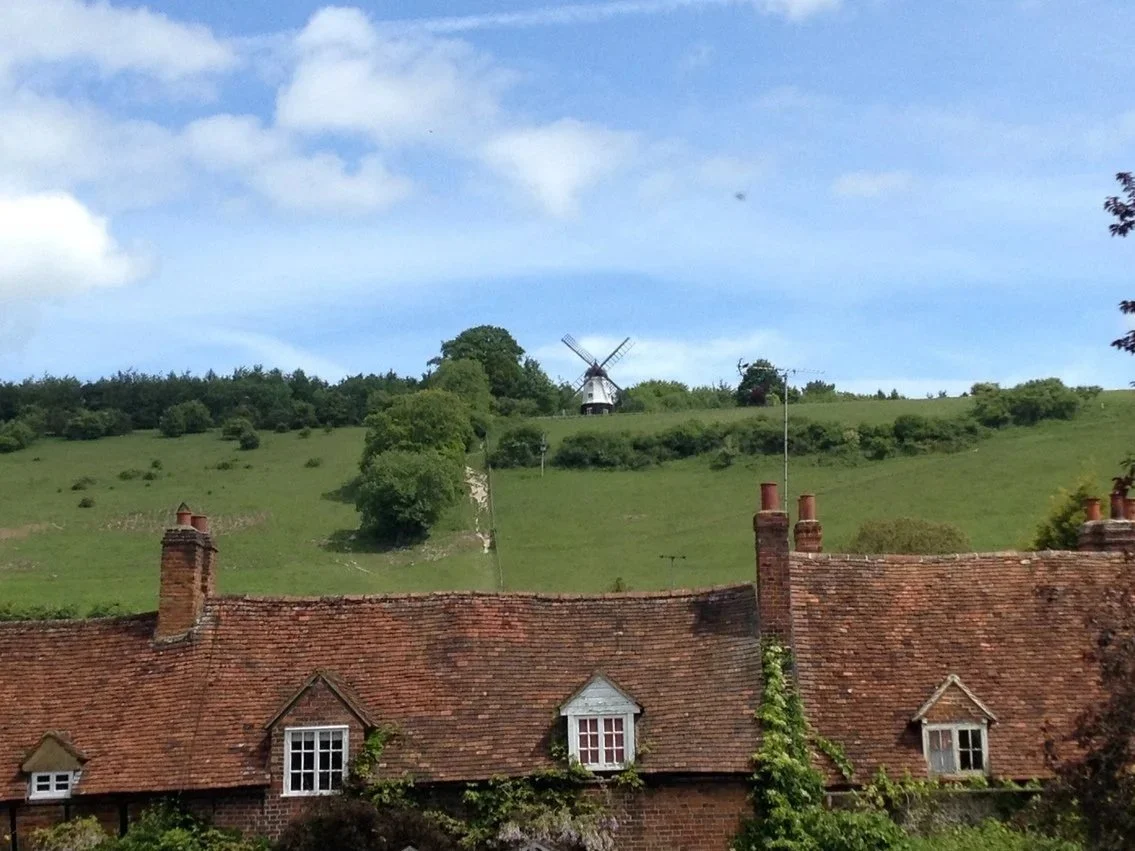
TURVILLE, SKIRMETT, FRIETH
Turville, Skirmett, and Frieth are three picturesque Chiltern villages nestled in the Hambleden Valley, between Marlow and Henley-on-Thames. The area is renowned for its rolling hills, peaceful countryside, and dense tree cover, forming part of the Chiltern Hills Area of Outstanding Natural Beauty (AONB).
The landscape around these villages is heavily wooded, dominated by mature beech trees, which give the hills their distinctive colour through the seasons — from bright green in spring to deep gold in autumn. You’ll also find oak, ash, sycamore, hornbeam, and birch, along with hazel and hawthorn in hedgerows and willow and alder in valley bottoms.
Together, Turville, Skirmett, and Frieth sit in one of the most leafy and scenic parts of Buckinghamshire, where ancient woodland, farmland, and traditional cottages blend seamlessly. It’s an area that perfectly captures the natural beauty and timeless charm of the Chilterns.
At Elementree Care, tree surgery is more than service it’s an art form.
We proudly serve residential and commercial clients throughout Amersham, Beaconsfield, Henley-on-Thames, Slough, High Wycombe, Chesham, Marlow, Maidenhead, Cookham, Great Missenden, Burnham, Taplow, and the wider Chiltern & Thames Valley area.
From crown reductions and tree removals to hedge shaping and stump grinding, our team approaches every project with precision, respect for nature, and a passion for detail.
Use the interactive map to explore our full service area.